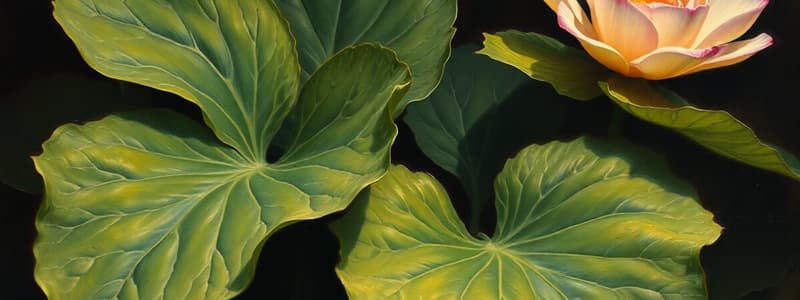Podcast
Questions and Answers
The process responsible for a plant wilting when its cells lose turgor is called fermentation.
The process responsible for a plant wilting when its cells lose turgor is called fermentation.
False (B)
Microorganisms die when high sugar concentration is applied in food preservation due to the removal of water by osmosis.
Microorganisms die when high sugar concentration is applied in food preservation due to the removal of water by osmosis.
True (A)
Salting fish and beef preserves them primarily by enhancing their texture.
Salting fish and beef preserves them primarily by enhancing their texture.
False (B)
Tying knots at the ends of the visking tubing in the osmosis experiment is done to create a loop.
Tying knots at the ends of the visking tubing in the osmosis experiment is done to create a loop.
Distilled water serves as the control in the osmosis experiment using visking tubing.
Distilled water serves as the control in the osmosis experiment using visking tubing.
The mass of the visking tubing containing concentrated sucrose solution decreases when suspended in distilled water.
The mass of the visking tubing containing concentrated sucrose solution decreases when suspended in distilled water.
Replicating the osmosis experiment helps to increase confidence in the findings by validating the results.
Replicating the osmosis experiment helps to increase confidence in the findings by validating the results.
An increase in turgidity of the visking tubing containing concentrated glucose solution demonstrates respiration.
An increase in turgidity of the visking tubing containing concentrated glucose solution demonstrates respiration.
Osmosis is the movement of water molecules from a region of lower water concentration to a region of higher water concentration.
Osmosis is the movement of water molecules from a region of lower water concentration to a region of higher water concentration.
Diffusion is a passive process that does not require energy.
Diffusion is a passive process that does not require energy.
Turgor pressure is the pressure exerted by the cytoplasm against the cell wall, helping to maintain cell firmness.
Turgor pressure is the pressure exerted by the cytoplasm against the cell wall, helping to maintain cell firmness.
All substances can freely pass through selectively permeable membranes.
All substances can freely pass through selectively permeable membranes.
Transpiration of water vapor through stomata is an example of osmosis.
Transpiration of water vapor through stomata is an example of osmosis.
The mass of a substance does affect the rate of diffusion.
The mass of a substance does affect the rate of diffusion.
Water cannot enter a plant cell by osmosis when it is turgid.
Water cannot enter a plant cell by osmosis when it is turgid.
Diffusion occurs from a region of low concentration to a region of high concentration.
Diffusion occurs from a region of low concentration to a region of high concentration.
Osmosis is a specific type of diffusion that involves water movement through a semipermeable membrane.
Osmosis is a specific type of diffusion that involves water movement through a semipermeable membrane.
Factors affecting the rate of diffusion include temperature, concentration difference, and the mass of the substance.
Factors affecting the rate of diffusion include temperature, concentration difference, and the mass of the substance.
Flashcards are hidden until you start studying
Study Notes
Osmosis and Turgor Pressure
- Osmosis is the movement of water molecules across a semipermeable membrane from an area of higher water concentration to an area of lower water concentration.
- Turgor pressure is the pressure exerted by the cytoplasm and vacuole against the cell wall of a plant.
- Wilting occurs when plant cells lose turgor due to water loss through osmosis.
- High sugar concentrations in food preservation kill microorganisms by removing water through osmosis, preventing reinfection.
- Salting fish and beef also uses osmosis to remove water from microorganisms, resulting in their death.
- In an osmosis experiment, tying knots at the ends of visking tubing prevents leakage of solutions.
- In an osmosis experiment, the control group is the tube containing distilled water.
- When a visking tubing containing concentrated sucrose solution is suspended in distilled water, its mass increases because water moves into the solution through osmosis.
- Replicating osmosis experiments or cross-referencing results with other groups helps validate the findings.
- The increase in turgidity of a visking tubing containing concentrated glucose solution demonstrates osmosis.
Diffusion
- Diffusion is the movement of molecules from a region of high concentration to a region of low concentration.
- Diffusion is a passive process, meaning it does not require energy.
- Temperature, concentration difference, and distance all influence the rate of diffusion.
- Transpiration of water vapor through stomata of a leaf is an example of diffusion.
- The mass of a substance does not affect the rate of diffusion.
- A plant cell is considered turgid when no more water can enter the cell by osmosis, meaning the inward pressure of water equals the resistance of the cell wall.
Studying That Suits You
Use AI to generate personalized quizzes and flashcards to suit your learning preferences.




